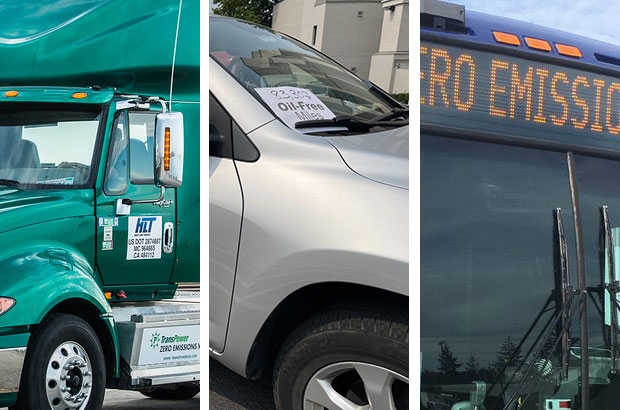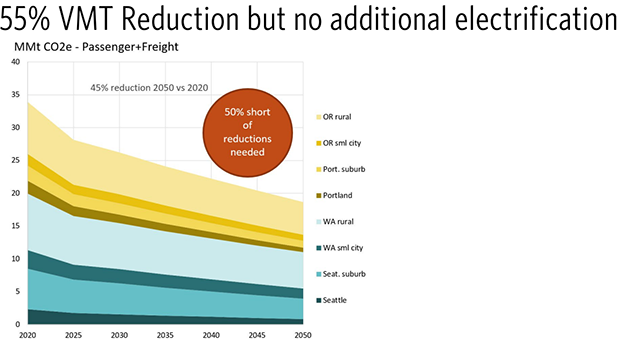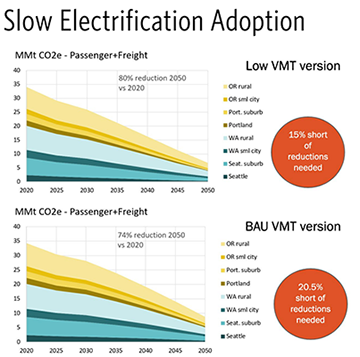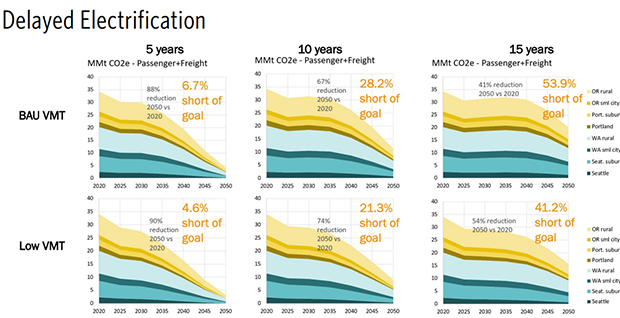About our Transforming Transportation blog series: This article, part 3, describes critical conclusions from our research on how to cut pollution from our transportation sector. Previously in the series, part 2 summarized research findings on clean energy needs to achieve transportation decarbonization. Part 1 described two pathways for cutting pollution. Click here for more details about this research, including our full white paper and summary report.
The research is clear: to cut climate pollution on the scale and timeframe recommended by scientists, we need to electrify nearly all of the vehicles on the road. This transition will be great for our health and will lower the cost for people and goods to get around, but when we pair electrification with expanded transit, walking, and biking options, we see even greater benefits. After modeling what it will take to decarbonize our transportation system in Washington and Oregon while relying on a clean electricity grid, we wanted to answer key questions about electrifying transportation:
- Why do we need to electrify? What happens to our climate pollution if we don’t electrify and just severely reduce how much we drive?
- We are already transitioning to electric vehicles, but what if uptake is slow?
- Are there impacts to delaying a rapid transition to electric vehicles?
We dug into these questions and came away with a renewed urgency to support the transition to electric vehicles of all types through supportive policies and investments. At the same time, it’s clear we need to expand clean and convenient options for getting around.
Why do we need to electrify? What happens to our climate pollution if we don’t electrify and just severely reduce how much we drive?
For our research, our core scenarios looked at electrifying nearly 100% of all vehicles on the road (passenger vehicles, transit buses, freight vehicles, and more) in Washington and Oregon and combining that level of electrification with business as usual, lower, or higher levels of vehicle miles traveled (VMT). But what happens if we flip the script: what if we drastically reduce how much we drive or move our goods by vehicle—but don’t support electrification beyond a slow business as usual scenario?
Simply reducing the amount we drive—without a transition to electric vehicles—won't achieve our climate goals. Not even close.
To test this, we matched different parts of Washington and Oregon with VMT levels from elsewhere in the world that have very well built-out transit systems, many decades in the making. We cut VMT for individuals moving around in Portland, Seattle, and small cities in both states by more than half, resulting in lower VMT than London, Berlin, and even Paris. We matched VMT for the Seattle and Portland suburbs to around that of London, and rural areas achieve a VMT level much lower than New York (the state with the lowest VMT). We also reduce freight VMT by 20%. All of this together is a VMT reduction of 55%—a really transformative shift.
But even with a transformative reduction in VMT, this shift does not get us to our pollution reduction goals in the region—in fact, it’s not even close. We see a 45% reduction in climate pollution by 2050, but we need to see at least a 95% reduction for Oregon and Washington.
So, what if we achieve these significant VMT reductions and then electrify just enough vehicles to meet our climate goals? How much electrification is enough? It turns out that even with these deep VMT reductions, spurred by massively increased transit, more people walking and biking, and a reduced need to travel in the first place, achieving our greenhouse gas reduction requirements will still rely heavily on electrification of most vehicles: at minimum, we would still need to electrify 97% of passenger vehicles, 96% of transit buses, and 85% of medium- and heavy-duty freight by 2050. At the end of the day, near-zero means near-zero—that is to say, nearly zero of the vehicles still on the road can be polluting.
Yet it’s still worth cutting vehicle mileage. Even though relying on VMT reductions in isolation does not achieve our greenhouse gas reduction requirements, it is an important piece of the puzzle and these deep reductions in VMT provide additional benefits. The average person would save $4,775 annually thanks to reduced reliance on vehicles, and lower fuel costs of electric vehicles for those still driving. States would have to spend more on transit, but that would be more than compensated for by lower road maintenance costs. We would also see fewer injuries and deaths due to vehicle crashes. Overall, while reducing VMT is not the key driver of emissions reductions, it is very important for health, safety and economic benefits.
We are already transitioning to electric vehicles, but what if uptake is slow?
Automakers, consumers and others are already transitioning to electric vehicles. Some have argued that the private market is already adjusting and thus we do not need additional policies to accelerate the adoption of cleaner vehicles. So can we meet our climate goals for the Pacific Northwest and hold electrification at a slower rate compared to electrifying basically all vehicles by 2050? What if 80% of passenger vehicles, 90% of transit buses, 75% of medium-duty freight, and 72% of heavy-duty freight are electric by 2050, as opposed to nearly 100%? That’s still a big shift and unfortunately, it doesn’t get us to our goals for cutting pollution in the region.
If we apply this “slow” electrification trajectory to business-as-usual travel patterns, we are 20.5% short of our pollution reduction goal. If we pair this with VMT that is reduced by 27% compared to VMT, we’re still 15% short of our goal. Though we already have strong policies in Washington and Oregon requiring an increase in new zero emission cars and trucks being sold, we will need policies to make sure that everyone is able to access electric vehicles of all types and to accelerate the transition away from existing, polluting vehicles.
Are there impacts to delaying a rapid transition to electric vehicles?
We often hear that “now is not the time” to push for climate action, including vehicle electrification. So what if we wait, and push out rapid vehicle electrification out by 5, 10, or 15 years? For example, what if we hit 100% electric passenger vehicles in 2055, rather than 2050? Unfortunately, even a five-year delay put us off track in ensuring greater climate stability. And longer delays would mean our region falls even further from our goal, even when paired with significantly reduced VMT.
What does this mean?
We must act quickly to electrify nearly all vehicles on the road. This transition is beginning: in Washington, the number of EVs on the road surged by 40% in 2021. In Oregon, EV registrations were 80% higher in 2021 than the previous year. The number of public charging stations has been consistently and quickly growing across the country. Given the scale of the transition needed, our policymakers and elected leaders must continue at an increasing speed—which means we will need more supportive policies and investments to get us to where we need to go.
Yet, electrification alone is not the optimal solution. While we could meet our decarbonization goals by focusing on transportation electrification alone, it is not prudent to do so. We can see even broader health, safety, and economic benefits when electrification is paired with increased transit use, walking, and biking. The need to electrify is unavoidable, but it’s easier to do so and brings broader benefits when we take a holistic approach and expand transportation options outside of personal vehicles. Electrifying is necessary for the climate, and good for our health and wallets. When combined with expanded transit and options to walk and roll, these benefits are amplified.
To make the transition possible for all, our elected leaders need to invest in charging infrastructure, providing funding to electrify fleets; support low-income people in accessing clean transportation options; improve our land use policy so people are able to live closer to work, services, and amenities; and more. That’s why we are continuously advocating for a number of climate-friendly transportation policies and investments at any given time in both Washington and Oregon, and can always use your support.
Appreciate this research? Please share it with others and let your elected officials know how necessary it is to electrify our transportation–quickly!








